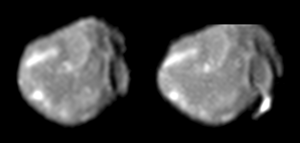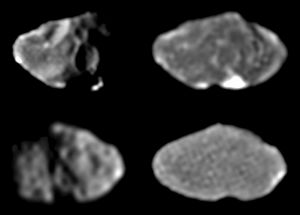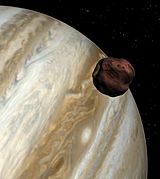Amalthea (moon) facts for kids

Galileo images of Amalthea
|
|
| Discovery | |
|---|---|
| Discovered by | E. E. Barnard |
| Discovery date | September 9, 1892 |
| Orbital characteristics | |
| Periapsis | 181,150 km |
| Apoapsis | 182,840 km |
|
Mean orbit radius
|
181365.84 ± 0.02 km (2.54 RJ) |
| Eccentricity | 0.00319 ± 0.00004 |
| 0.49817943 ± 0.00000007 d (11 h 57 min 23 s) | |
|
Average orbital speed
|
26.57 km/s |
| Inclination | 0.374 ± 0.002° (to Jupiter's equator) |
| Satellite of | Jupiter |
| Physical characteristics | |
| Dimensions | 250×146×128 km³ |
|
Mean radius
|
83.5 ± 2.0 km |
| Volume | (2.43 ± 0.22)×106 km³ |
| Mass | 2.08 ± 0.15×1018 kg |
|
Mean density
|
0.857 ± 0.099 g/cm³ |
| ~0.020 m/s² (~0.002 g) | |
| ~0.058 km/s | |
| synchronous | |
| zero | |
| Albedo | 0.090 ± 0.005 |
| 14.1 | |
Amalthea is the third closest moon to the giant planet Jupiter. It was discovered on September 9, 1892, by an astronomer named Edward Emerson Barnard. This moon is named after Amalthea, a nymph (a nature spirit) from Greek mythology. You might also hear it called Jupiter V.
If you stood on Amalthea, Jupiter would look incredibly huge in the sky. It would appear 92 times bigger than a Full Moon seen from Earth! Amalthea is the largest of Jupiter's inner moons. It's not perfectly round and has a reddish color. Scientists think it's made mostly of water ice mixed with other materials. Its surface is covered with large craters and tall mountains.
Spacecraft have taken pictures of Amalthea. The Voyager 1 and 2 probes snapped photos in 1979 and 1980. Later, the Galileo orbiter took even more detailed pictures in the 1990s.
Contents
Discovering Amalthea
Amalthea was found on September 9, 1892. Edward Emerson Barnard discovered it using a powerful telescope at Lick Observatory. This was a big deal because it was the first new moon of Jupiter found since Galileo Galilei discovered the four largest moons (the Galilean moons) way back in 1610.
How Amalthea Got Its Name
The moon is named after Amalthea, a nymph from Greek mythology. She was said to have cared for the infant Zeus. Zeus is the Greek god who is like the Roman god Jupiter.
Amalthea is also known by its Roman numeral name, Jupiter V. The official name "Amalthea" was not approved until 1975. However, people had been using it for many years before that. The name was first suggested by Camille Flammarion. Before 1975, it was mostly just called Jupiter V.
Amalthea's Orbit Around Jupiter
Amalthea travels around Jupiter at a distance of about 181,000 kilometers. This is about 2.54 times Jupiter's own radius. Amalthea's path around Jupiter is almost a perfect circle. It is also very close to Jupiter's equator.
What Amalthea Looks Like
The surface of Amalthea is very red. This reddish color might come from sulfur that has escaped from Io, another one of Jupiter's moons. It could also be from other materials that are not ice. There are also some bright patches of green on Amalthea's slopes. Scientists are still not sure what causes this green color. Amalthea's surface is a bit brighter than the surfaces of Jupiter's other inner moons.

Views from and to Amalthea
How Amalthea Looks from Jupiter
If you could stand on Jupiter's cloud tops, Amalthea would look very bright. It would shine almost as brightly as Venus does when we see it from Earth.
How Jupiter Looks from Amalthea
From Amalthea's surface, Jupiter would look absolutely enormous! It would appear 92 times larger than the Full Moon looks from Earth. Imagine seeing a planet that huge in your sky!

Exploring Amalthea
In 1979 and 1980, the Voyager 1 and 2 spacecraft flew past Jupiter. They took the first pictures of Amalthea that showed its surface details. These probes also measured the moon's surface temperature.
Later, the Galileo orbiter took even more detailed pictures of Amalthea's surface. It also made a close flyby. This helped scientists learn more about what the moon is made of and what its inside is like.
Images for kids
See also
 In Spanish: Amaltea (satélite) para niños
In Spanish: Amaltea (satélite) para niños







